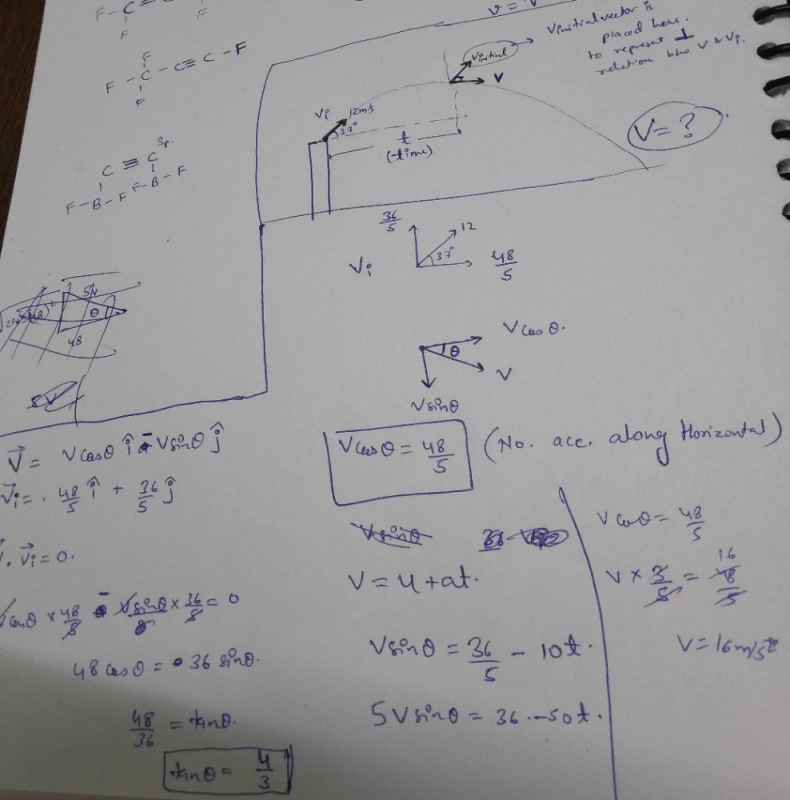JEE Exam > JEE Questions > A stone is thrown at a speed of 12m/s from to...
Start Learning for Free
A stone is thrown at a speed of 12m/s from top of high tower at an angle 37 above horizontal.after few seconda the velocity becomes perpendicular to velocity of projection.find the magnitude of this velocity?
Most Upvoted Answer
A stone is thrown at a speed of 12m/s from top of high tower at an ang...
**Problem Analysis:**
In this problem, we have a stone thrown from the top of a high tower at an angle of 37 degrees above the horizontal. We are asked to find the magnitude of the velocity when the stone's velocity becomes perpendicular to its initial velocity.
**Initial Velocity Components:**
To solve this problem, we first need to find the initial velocity components of the stone. The given initial speed is 12 m/s, and the angle of projection is 37 degrees above the horizontal. We can use trigonometry to find the horizontal and vertical components of the initial velocity.
The horizontal component (Vx) can be found using the equation:
Vx = V * cos(θ)
where V is the initial speed and θ is the angle of projection.
Substituting the given values:
Vx = 12 * cos(37°) = 9.6 m/s
The vertical component (Vy) can be found using the equation:
Vy = V * sin(θ)
where V is the initial speed and θ is the angle of projection.
Substituting the given values:
Vy = 12 * sin(37°) = 7.2 m/s
**Vertical Component Becomes Zero:**
Next, we need to find the time it takes for the vertical component of the velocity to become zero. We can use the equation of motion for vertical motion:
Vy = Vy0 + gt
where Vy is the vertical component of velocity, Vy0 is the initial vertical component of velocity, g is the acceleration due to gravity, and t is time.
Since the stone is thrown upwards, the initial vertical component of velocity is positive. Therefore, we can rewrite the equation as:
0 = 7.2 + (-9.8)t
Simplifying the equation, we get:
9.8t = 7.2
t = 7.2 / 9.8 = 0.735 seconds
**Horizontal Component Remains Constant:**
Since there is no horizontal force acting on the stone, the horizontal component of velocity remains constant throughout the motion. Therefore, the horizontal component of velocity after 0.735 seconds will also be 9.6 m/s.
**Final Velocity:**
To find the magnitude of the final velocity, we can use the Pythagorean theorem. The final velocity vector is the vector sum of the horizontal and vertical components:
V = √(Vx^2 + Vy^2)
Substituting the values:
V = √(9.6^2 + 0^2) = 9.6 m/s
So, the magnitude of the final velocity when the stone's velocity becomes perpendicular to its initial velocity is 9.6 m/s.
**Conclusion:**
In this problem, we found the magnitude of the final velocity when a stone thrown from the top of a high tower at an angle of 37 degrees above the horizontal has a velocity perpendicular to its initial velocity. The magnitude of the final velocity was found to be 9.6 m/s.
In this problem, we have a stone thrown from the top of a high tower at an angle of 37 degrees above the horizontal. We are asked to find the magnitude of the velocity when the stone's velocity becomes perpendicular to its initial velocity.
**Initial Velocity Components:**
To solve this problem, we first need to find the initial velocity components of the stone. The given initial speed is 12 m/s, and the angle of projection is 37 degrees above the horizontal. We can use trigonometry to find the horizontal and vertical components of the initial velocity.
The horizontal component (Vx) can be found using the equation:
Vx = V * cos(θ)
where V is the initial speed and θ is the angle of projection.
Substituting the given values:
Vx = 12 * cos(37°) = 9.6 m/s
The vertical component (Vy) can be found using the equation:
Vy = V * sin(θ)
where V is the initial speed and θ is the angle of projection.
Substituting the given values:
Vy = 12 * sin(37°) = 7.2 m/s
**Vertical Component Becomes Zero:**
Next, we need to find the time it takes for the vertical component of the velocity to become zero. We can use the equation of motion for vertical motion:
Vy = Vy0 + gt
where Vy is the vertical component of velocity, Vy0 is the initial vertical component of velocity, g is the acceleration due to gravity, and t is time.
Since the stone is thrown upwards, the initial vertical component of velocity is positive. Therefore, we can rewrite the equation as:
0 = 7.2 + (-9.8)t
Simplifying the equation, we get:
9.8t = 7.2
t = 7.2 / 9.8 = 0.735 seconds
**Horizontal Component Remains Constant:**
Since there is no horizontal force acting on the stone, the horizontal component of velocity remains constant throughout the motion. Therefore, the horizontal component of velocity after 0.735 seconds will also be 9.6 m/s.
**Final Velocity:**
To find the magnitude of the final velocity, we can use the Pythagorean theorem. The final velocity vector is the vector sum of the horizontal and vertical components:
V = √(Vx^2 + Vy^2)
Substituting the values:
V = √(9.6^2 + 0^2) = 9.6 m/s
So, the magnitude of the final velocity when the stone's velocity becomes perpendicular to its initial velocity is 9.6 m/s.
**Conclusion:**
In this problem, we found the magnitude of the final velocity when a stone thrown from the top of a high tower at an angle of 37 degrees above the horizontal has a velocity perpendicular to its initial velocity. The magnitude of the final velocity was found to be 9.6 m/s.
Community Answer
A stone is thrown at a speed of 12m/s from top of high tower at an ang...

Attention JEE Students!
To make sure you are not studying endlessly, EduRev has designed JEE study material, with Structured Courses, Videos, & Test Series. Plus get personalized analysis, doubt solving and improvement plans to achieve a great score in JEE.

|
Explore Courses for JEE exam
|

|
Similar JEE Doubts
A stone is thrown at a speed of 12m/s from top of high tower at an angle 37 above horizontal.after few seconda the velocity becomes perpendicular to velocity of projection.find the magnitude of this velocity?
Question Description
A stone is thrown at a speed of 12m/s from top of high tower at an angle 37 above horizontal.after few seconda the velocity becomes perpendicular to velocity of projection.find the magnitude of this velocity? for JEE 2024 is part of JEE preparation. The Question and answers have been prepared according to the JEE exam syllabus. Information about A stone is thrown at a speed of 12m/s from top of high tower at an angle 37 above horizontal.after few seconda the velocity becomes perpendicular to velocity of projection.find the magnitude of this velocity? covers all topics & solutions for JEE 2024 Exam. Find important definitions, questions, meanings, examples, exercises and tests below for A stone is thrown at a speed of 12m/s from top of high tower at an angle 37 above horizontal.after few seconda the velocity becomes perpendicular to velocity of projection.find the magnitude of this velocity?.
A stone is thrown at a speed of 12m/s from top of high tower at an angle 37 above horizontal.after few seconda the velocity becomes perpendicular to velocity of projection.find the magnitude of this velocity? for JEE 2024 is part of JEE preparation. The Question and answers have been prepared according to the JEE exam syllabus. Information about A stone is thrown at a speed of 12m/s from top of high tower at an angle 37 above horizontal.after few seconda the velocity becomes perpendicular to velocity of projection.find the magnitude of this velocity? covers all topics & solutions for JEE 2024 Exam. Find important definitions, questions, meanings, examples, exercises and tests below for A stone is thrown at a speed of 12m/s from top of high tower at an angle 37 above horizontal.after few seconda the velocity becomes perpendicular to velocity of projection.find the magnitude of this velocity?.
Solutions for A stone is thrown at a speed of 12m/s from top of high tower at an angle 37 above horizontal.after few seconda the velocity becomes perpendicular to velocity of projection.find the magnitude of this velocity? in English & in Hindi are available as part of our courses for JEE.
Download more important topics, notes, lectures and mock test series for JEE Exam by signing up for free.
Here you can find the meaning of A stone is thrown at a speed of 12m/s from top of high tower at an angle 37 above horizontal.after few seconda the velocity becomes perpendicular to velocity of projection.find the magnitude of this velocity? defined & explained in the simplest way possible. Besides giving the explanation of
A stone is thrown at a speed of 12m/s from top of high tower at an angle 37 above horizontal.after few seconda the velocity becomes perpendicular to velocity of projection.find the magnitude of this velocity?, a detailed solution for A stone is thrown at a speed of 12m/s from top of high tower at an angle 37 above horizontal.after few seconda the velocity becomes perpendicular to velocity of projection.find the magnitude of this velocity? has been provided alongside types of A stone is thrown at a speed of 12m/s from top of high tower at an angle 37 above horizontal.after few seconda the velocity becomes perpendicular to velocity of projection.find the magnitude of this velocity? theory, EduRev gives you an
ample number of questions to practice A stone is thrown at a speed of 12m/s from top of high tower at an angle 37 above horizontal.after few seconda the velocity becomes perpendicular to velocity of projection.find the magnitude of this velocity? tests, examples and also practice JEE tests.

|
Explore Courses for JEE exam
|

|
Suggested Free Tests
Signup for Free!
Signup to see your scores go up within 7 days! Learn & Practice with 1000+ FREE Notes, Videos & Tests.

























